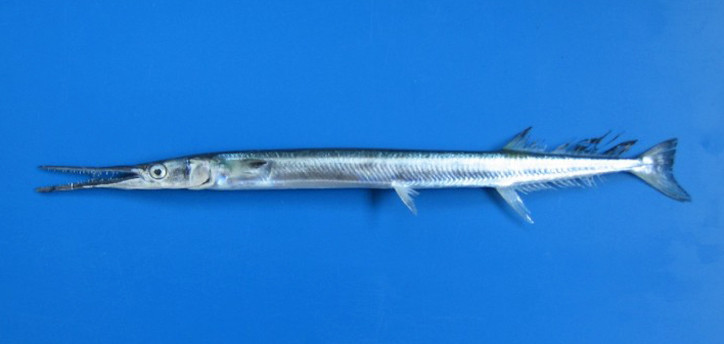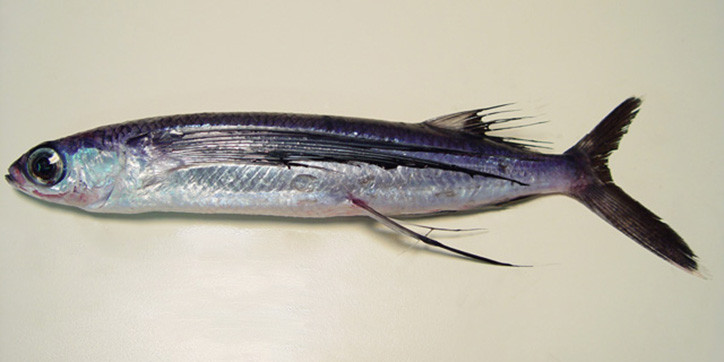The Beloniformes order, belonging to the Acanthopterygii superorder, comprises six families. Four families of this order inhabit the Adriatic Sea.
The Belonidae family includes 10 genera and about 32 species. Most of them inhabit seawater, but some of them inhabit freshwater bodies as well. The largest representative of the family are Tylosurus crocodilus, which inhabits the basins of the Indian and Pacific Ocean and can be 1.5 meters long and weigh 6.4 kilograms, and Tylosurus fodiator, which inhabits the central eastern part of the Pacific Ocean and can be 1.34 meters long and weigh 9.9 kilograms.

(“Awabi and Sayori”. Utagawa Hiroshige. 1832.)
In some situations, large ocean garfishes can injure people with their long, thin beaks. A few deaths were reported after running into them underwater. Most likely, it happened accidentally, due to the fact that garfishes can move at high speed during sharp throws, and a bather or diver, who is in the way of such an “arrow”, can become its victim.

(Tylosurus fodiator weighing 8.8 kilograms. Photo by © Wesley Brough. internationalfishingnews.blogspot.com)
Quite often, garfishes jump out of the water in order to leap over the objects floating on the surface, including boats. They jump at high speed, sometimes reaching up to 60 kilometers per hour. In such a situation, large garfishes can be dangerous to sitters. There are cases, when such jumps caused serious injuries to anglers. However, all these horrible stories have nothing to do with the representatives of the Belonidae family, inhabiting the Adriatic.
The following two representatives of the Belonidae family inhabit the Adriatic Sea:

(Garfish. Photo © lagunaproject.it)
It is a pelagic schooling species. It swims near the surface and often comes close to the coast. The maximum recorded length is 93 cm; specimens up to 45 cm long are more common. The maximum weight is 1.3 kilograms. It feeds on small fish. European garfish is a thermophilic fish that migrates to the shore in spring and summer. When the water becomes colder, it moves to deeper areas and spends the winter with little or no activity. It is a permanent inhabitant of the Adriatic Sea.

(Tylosurus acus imperialis. Photo © podvodni.hr)
It is a pelagic species. Usually, it swims no deeper than 10 meters from the surface. The maximum recorded length is 140 cm. Occasionally, it comes close to the shore. It is a rare inhabitant of the Adriatic Sea. It is a poorly studied species.
Representatives of the medium-sized Scomberesocidae family are fishes inhabiting the subsurface zone of subtropical and temperate waters of the seas and oceans. We know the representatives of Scomberesocidae by the common name of their commercial species, “sauries”. These fishes can be found frozen on the shelves of stores or in cans under this name. Scomberesocidae often jump out of the water, swimming near the surface. They resemble flying fishes, while skimming the water surface. Only one representative of the family inhabits the Adriatic Sea.
Atlantic saury (Scomberesox saurus).

(Atlantic saury. Photo by © A.M. Arias. ictioterm.es)
It is a pelagic schooling species. It swims near the surface, usually no deeper than 30 meters. Sometimes, it comes close to the shore. The maximum recorded length is 50 cm; specimens up to 32 cm long are more common. It feeds on zooplankton, fry and fish eggs. It is a permanent inhabitant of the Adriatic Sea.
Hemiramphidae is a fairly large family, comprising more than 100 species of different genera. Hemiramphidae are the inhabitants of almost all the world’s warm sea waters. Some species inhabit fresh waters of South America. They are omnivorous fishes that prefer to swim near the sea surface. Like many other fishes of the order, they may jump out of the water and keep flying over the surface over considerable distances. Only one representative of the family inhabits the Adriatic Sea.
Black-barred halfbeak (Hemiramphus far).

(Black-barred halfbeak. Photo by © John E. Randall. fishbase.org)
It prefers to swim at the depths of up to 6 meters. It is a schooling fish preferring to swim near the rocky reefs and islands surrounded by rich aquatic vegetation. The maximum recorded length is 45 cm; specimens up to 30 cm long are more common. It feeds on plants and algae. It got into the Mediterranean Sea through the Suez Canal. It was found a couple of times in the southern part of the Adriatic.
The Exocoetidae family belongs to the Beloniformes order as well. It comprises 64 species, combined in 7-9 genera, according to different classifications. Using wide pectoral fins, flying fishes may jump out of the water and keep flying over the surface over considerable distances at high speeds, reaching 30 to 80 kilometers per hour. The fish can use air currents and cover the distances of up to 400 meters, usually no more than 50 meters. The maximum height of the jump is about 6 meters above the sea surface.
In some countries, such as Barbados, flying fishes are actively used when cooking national dishes. In Japan, the roe of opaque-winged flying fish, or Cheilopogon agoo, is popular in sushi cooking. Moreover, national dishes from flying fish can be found in Taiwan, Vietnam, China, Indonesia, India and other countries.
The following 5 representatives of the family inhabit the Adriatic Sea:
Mediterranean flyingfish (Cheilopogon heterurus).

(Mediterranean flyingfish. Photo by © A.M. Arias. ictioterm.es)
It is a pelagic coastal species. The maximum recorded length is 40 cm; specimens up to 15 cm long are more common. It feeds on plankton and small crustaceans. It usually enters the Adriatic Sea from the Mediterranean Sea in late summer – early autumn, rarely swimming upstream to its northern part.
Oceanic two-wing flyingfish (Exocoetus obtusirostris).

(Oceanic two-wing flyingfish. Photo © Ichthyology Database of the Swedish Museum of Natural History. artedi.nrm.se)
It is a coastal pelagic schooling species. It inhabits the surface waters, usually no deeper than 20 meters. The maximum recorded length is 24 cm; specimens up to 20 cm long are more common. It feeds on plankton and small crustaceans. There were unconfirmed encounters with this fish in the southern part of the Adriatic Sea. It is a rare species.
Tropical two-wing flyingfish (Exocoetus volitans).

(Tropical two-wing flyingfish. Photo © navsource.org)
It is a pelagic coastal species. It inhabits the surface waters, usually no deeper than 20 meters. The maximum recorded length is 30 cm; specimens up to 20 cm long are more common. It feeds on plankton and small crustaceans. It is a rare inhabitant of the southern part of the Adriatic Sea, swimming from the Mediterranean Sea in late summer – early autumn.
Black wing flyingfish (Hirundichthys rondeletii).

(Black wing flyingfish. Photo by © Brandi Noble. NOAA\NMFS\Mississippi Laboratory. fishbase.org)
It is a pelagic schooling species. It inhabits the surface waters, usually no deeper than 20 meters. The maximum recorded length is 30 cm; specimens up to 20 cm long are more common. It feeds on plankton and small crustaceans. It is a permanent inhabitant of the Adriatic Sea.
African sailfin flyingfish (Parexocoetus mento).

(African sailfin flyingfish. Photo © zukan.com)
It is a pelagic coastal schooling species. It inhabits the surface waters, usually no deeper than 20 meters. The maximum recorded length is 13 cm. It feeds on plankton and small crustaceans. It is a rare species in the Adriatic that swam to the Mediterranean Sea through the Suez Canal.